Derived from the Greek term mythologia that means “the telling of stories”, mythology describes a group of stories that attempts to explain the nature of the world, from the existence of humans to the occurrence of natural disasters.
Through history, cultures around the world have framed their beliefs and actions around these stories, and some have even transformed into bedtime stories.
Mythology came into being through observation and a dash of imagination. For example, before astronomers gave us a better understanding of planetary movement many peoples believed that solar eclipses happened when a demon or dragon ate the sun.
While belief in ancient or native mythologies has waned, the stories continue to influence culture, particularly literature, today.
Writers find much creative content in the myths of old to imbue in their work.
Many ancient works center on the mythology of the cultures in which they were written, from Homer’s Illiad and Odyssey on Greek gods and heroes to Virgil’s Aeneid on Roman deities to the Celtic epic Beowulf on the feats of that mighty warrior.
Even today mythology winds through literature. In the West, a main character’s weakness might be called his “Achilles heel”, a difficult task may be described as “Herculean”, or a matchmaker’s work may be compared to “playing Cupid.” All of these phrases come from ancient Greek mythology. In addition, fantasy novels such as Tolkien’s Lord of the Rings draw inspiration from the myths of Northern Europe and creatures like elves and dwarves found therein.
RELATED: Best Mattresses for Children
Learning about mythology from around the world expands our understanding of the history and cultures of others, and may also help us better understand and appreciate those allusions that we encounter in classic and contemporary literature.
Greek Mythology
- The Origin of Man – Each civilization has an origin story for mankind. The ancient Greek interpretation begins with men sprouting the from the earth like a tender flower.
- The Greek Olympians – The most well-known characters of Greek mythology are the Olympians, twelve gods who resided on Mount Olympus. Find out the stories behind this mighty pantheon.
- The Labors of Hercules – The personification of strength and struggle for the ancient Greeks, the demigod Hercules had to perform twelve seemingly-impossible labors as punishment for a crime.
- Greek Mythical Creatures – From the three-headed Cerberus to the long-lived phoenix, Greek mythology is rife with all different types of beings and beasts.
- Religious Beliefs & Practices in Ancient Greece – Religion affected all parts of Greek life, embodying the idea of an unseparated church and state. An engaging video from National Geographic gives a fascinating overview of this relationship.
Roman Mythology
- Major Roman Gods- When Rome came to power, the people modified Greek myths for themselves, giving Greek gods Roman names. Read about the identities and roles of the most important Roman gods.
- The Story of Romulus & Remus – According to myths, twin brothers who had been raised by a she-wolf founded the city of Rome.
- Spirit Worship in Ancient Rome – In addition to gods, the Romans believed in spirits that guarded households and inhabited all objects and places.
- Roman Mythology & the Planets – Astronomy played an important role in ancient Rome, so the names of many planets and moons have Roman origins. Learning about the relation between Roman astronomy and mythology provides insight into the characterizations of their major gods.
- Roman Religious Practices – Roman religion was a conglomeration of customs and beliefs from the many civilizations they conquered. These ranged from prayer to magic. Romans celebrated a variety of festivals and worshipped many supernatural beings.
Norse Mythology
- The Norse Creation Story – The Norse creation myth is complex and colorful that begins with the interplay between fire and ice and ends with the forming of the first humans from tree trunks.
- Family Tree of Norse Gods and Creatures- An amusing and informative cartoon illustrates the relationships among the gods and mystical creatures of Norse mythology.
- Major Norse Gods & Goddesses – While we don’t know as much about the Norse deities as the Greek or Roman, we can learn about some of more prominent ones. Read the histories of twelve of them.
- Supernatural Beings – In addition to the Æsir and the Vanir, the gods, and the jötnar”, the giants, Norse mythology invented many other supernatural beings, including elves and trolls.
- Stories from Norse Mythology – Browse through stories about the prominent characters of Norse myths.
Egyptian Mythology
- Egyptian Creation Story – The ancient Egyptian Book of the Dead and Pyramid Texts recount how the god Amun created himself from a void, then created the world through his children.
- Egyptian Gods & Goddesses – Click through the interactive chart to learn more about the major deities of ancient Egyptian mythology.
- Book of the Dead – This fun video from TEDEd walks you through the afterlife as the ancient Egyptians believed it to be.
- Animals in Egyptian Mythology – The ancient Egyptians held animals in high esteem, often giving their deities animal forms or replacing certain human features with those of animals, such as the head of a hawk for the sun god Ra.
- Ancient Egyptian Symbols – In ancient Egypt, where much of the population was illiterate, symbols like the pharaoh’s crook and flail served the important purpose of relaying important religious values.
Native American Mythology
- Creation Myths of the Blackfoot Tribe – Each Native American tribe has its own set of myths. According to the Blackfoot people, Old Man created earth, language, life, and death.
- Creation Story of the Lakota Tribe – According to the Lakota tribe, the Great Spirit, after destroying the old world by flood, rebuilt a new one with the help of Turtle.
- The Legend of Thunderbird – Thunderbird is an enormous bird that appears in the folklore of many native American tribes in both positive and negative lights.
- Creation of the Sun, Moon, & Stars – This Navajo legend tells how the First Man and the First Woman placed the celestial objects in the firmament.
- Concept of the Soul – Man has tried to define the soul since the beginning of time. The Native Americans developed different views of the soul, from interpreting it as breath to interpreting it as shadow.
Sumerian Mythology
- Mesopotamian Stores of Creation – Sumerians had several legends to explain the creation of the world. Some believed that the giant Marduk made heaven and earth from the body of his vanquished foe!
- Mesopotamian Religion – Professor Eugene Webb of the University of Washington provides a concise overview of Mesopotamian mythology, from the founding of Sumer to the development of the legends.
- Major Mesopotamian Deities- Sumerian mythology, and Mesopotamian mythology in general, had a large cast of deities. Five of the greatest were Anu, Inanna, Nanna, Ningirsu, and Shamash.
- Mesopotamian View on Life and Death – Evidence pieced together from many ancient texts provides insight into how Sumerians and surrounding peoples conceptualized life and the afterlife.
- The Epic of Gilgamesh – This epic poem is one of the earliest surviving great works of literature. It talks about the deities and legends of ancient Sumer.
Asian Mythology
- Pangu and the Creation of the World – The ancient Chinese believed that the sacrifice of shaggy giant named Pangu, who was born from the interaction between yin and yang, made the universe.
- The Creation of Japan – Japanese mythology credits the deities Izanagi and Izanami for giving birth to the islands of Japan and the deities that would guard them.
- Chinese Dragon Culture – In Chinese culture, the dragon is the most powerful creature. The people consider themselves descendants of the dragon.
- China’s Eight Immortals – The Eight Immortals are some of the most widely-recognized characters in Chinese mythology. They have the power to give life and destroy evil.
- Japanese Cherry Blossom Tree – Much of Japanese culture centers around nature, from haiku to mythology. The cherry blossom tree is particularly significant, said to symbolize the shortness of life and to house spirits.
Celtic Mythology
- The Celtic Myth Cycles – Celtic myth is told through four distinct cycles: the Mythological, the Ulster, the Fenian, and the Kingly/Historical.
- Celtic Gods & Goddesses – The Celts considered themselves descendants of the deities, making the gods and goddesses respected elder members of the Tribe.
- The Warrior Cúchulainn – One of the greatest heroes of Celtic myth, Cuchulain exhibited supernatural abilities early in life
- Animal Symbolism in Celtic Mythology – Thanks to their association with vitality and fertility and supposed connection to the spiritual realm, animals appear often in Celtic myths.
- Types of Irish Fairies – Of all of the mythical creatures of Celtic mythology, fairies are the best known. From the terrifying banshee to the playful leprechaun, there are plenty of fairies to discover in the Celtic wood.


